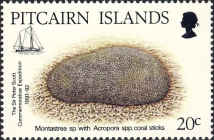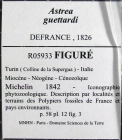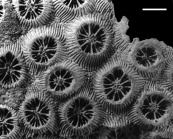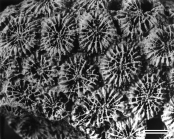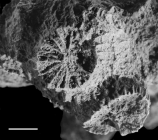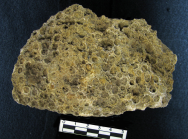WoRMS taxon details
Montastraea Blainville, 1830
204717 (urn:lsid:marinespecies.org:taxname:204717)
accepted
Genus
Astrea guettardi Defrance, 1826 † (type by subsequent designation)
Actinocoenia d'Orbigny, 1849 † · unaccepted (synonymy)
Aquitanastraea Chevalier, 1954 † · unaccepted > junior subjective synonym
Athecastraea Chevalier, 1961 † · unaccepted > junior subjective synonym
Heliastraea (Aquitanastraea) Chevalier, 1954 † · unaccepted > junior subjective synonym
Heliastraea (Athecastraea) Chevalier, 1961 † · unaccepted > junior subjective synonym
Heliastraea (Heliastreopsis) Chevalier, 1954 † · unaccepted > junior subjective synonym
Heliastreopsis Chevalier, 1954 † · unaccepted > junior subjective synonym
Montastraea (Athecastraea) Chevalier, 1961 † · unaccepted > junior subjective synonym
Montastrea Vaughan & Wells, 1943 † · unaccepted > junior homonym
Montastrea Blainville, 1830 · unaccepted > misspelling - incorrect subsequent spelling
Phyllocaeniopsis Chevalier, 1954 † · unaccepted > junior subjective synonym
Phyllocoenia Milne Edwards & Haime, 1848 · unaccepted > junior subjective synonym
- Species Montastraea cavernosa (Linnaeus, 1767)
- Species Montastraea annularis (Ellis & Solander, 1786) accepted as Orbicella annularis (Ellis & Solander, 1786) (unaccepted > superseded combination)
- Species Montastraea annuligera (Milne Edwards & Haime, 1849) accepted as Astrea annuligera Milne Edwards & Haime, 1849 (unaccepted > superseded combination)
- Species Montastraea aperta (Verrill, 1868) accepted as Mussismilia leptophylla (Verrill, 1868) (unaccepted > junior subjective synonym)
- Species Montastraea brasiliana (Verrill, 1901) accepted as Montastraea cavernosa (Linnaeus, 1767) (unaccepted > junior subjective synonym)
- Species Montastraea colemani Veron, 2000 accepted as Favites colemani (Veron, 2000) (unaccepted > superseded combination, basionym)
- Species Montastraea curta (Dana, 1846) accepted as Astrea curta (Dana, 1846) (unaccepted > superseded combination)
- Species Montastraea faveolata (Ellis & Solander, 1786) accepted as Orbicella faveolata (Ellis & Solander, 1786) (unaccepted > superseded combination)
- Species Montastraea forskaelana (Milne Edwards & Haime, 1849) accepted as Echinopora forskaliana (Milne Edwards & Haime, 1849) (unaccepted > superseded combination)
- Species Montastraea franksi (Gregory, 1895) accepted as Orbicella franksi (Gregory, 1895) (unaccepted > superseded combination)
- Species Montastraea hispidula (Verill, 1901) accepted as Orbicella annularis (Ellis & Solander, 1786) (unaccepted > junior subjective synonym)
- Species Montastraea magnistellata Chevalier, 1971 accepted as Favites magnistellata (Milne Edwards & Haime, 1849) (unaccepted > junior subjective synonym)
- Species Montastraea multipunctata Hodgson, 1985 accepted as Micromussa multipunctata (Hodgson, 1985) (unaccepted > superseded combination, basionym)
- Species Montastraea serageldini (Veron, 2000) accepted as Paramontastraea serageldini (Veron, 2000) (unaccepted > superseded combination)
- Species Montastraea truncata (Dana, 1846) accepted as Diploria labyrinthiformis (Linnaeus, 1758) (unaccepted > junior subjective synonym)
- Species Montastraea valenciennesi (Milne Edwards & Haime, 1849) accepted as Favites valenciennesii (Milne Edwards & Haime, 1849) (unaccepted > superseded combination)
marine, fresh, terrestrial
recent + fossil
de Blainville, H. M. (1830). Zoophytes. In: Dictionnaire des sciences naturelles, dans lequel on traitre méthodiquement des differéns êtres de la nature, considérés soit en eux-mêmes, d'après l'état actuel de nos connoissances, soit relativement à l'utlité qu'en peuvent retirer la médicine, l'agriculture, le commerce et les arts. Edited by F. G. Levrault. Tome 60. Paris, Le Normat. Pp. 548, pls. 68. <em>Paris, 1830.</em> 60 : 1-546., available online at https://www.biodiversitylibrary.org/page/25318344 [details]
Description 'En masses épaisses, composées de cellules tubuleuses assez serrées pour être polygonales, à bords non saillans, à...
Description Colonies are massive, either flat or dome-shaped. Corallites are monocentric and plocoid. Daughter corallites are...
Description 'En masses épaisses, composées de cellules tubuleuses assez serrées pour être polygonales, à bords non saillans, à cavité assez profonde, garnie de lamelles nombreuses, remontant le long d'une axe solide plus ou moins saillant.' (de Blainville, 1830: 339) [details]
Description Colonies are massive, either flat or dome-shaped. Corallites are monocentric and plocoid. Daughter corallites are...
Description Colonies are massive, either flat or dome-shaped. Corallites are monocentric and plocoid. Daughter corallites are predominantly formed by extratentacular budding, that is budding from the wall of parent corallites. Some intracentacular budding may also occur (Veron, 1986 <57>). [details]
Hoeksema, B. W.; Cairns, S. (2025). World List of Scleractinia. Montastraea Blainville, 1830. Accessed through: World Register of Marine Species at: https://www.marinespecies.org/aphia.php?p=taxdetails&id=204717 on 2025-04-04
Date
action
by
![]() The webpage text is licensed under a Creative Commons
Attribution 4.0 License
The webpage text is licensed under a Creative Commons
Attribution 4.0 License
Nomenclature
original description
de Blainville, H. M. (1830). Zoophytes. In: Dictionnaire des sciences naturelles, dans lequel on traitre méthodiquement des differéns êtres de la nature, considérés soit en eux-mêmes, d'après l'état actuel de nos connoissances, soit relativement à l'utlité qu'en peuvent retirer la médicine, l'agriculture, le commerce et les arts. Edited by F. G. Levrault. Tome 60. Paris, Le Normat. Pp. 548, pls. 68. <em>Paris, 1830.</em> 60 : 1-546., available online at https://www.biodiversitylibrary.org/page/25318344 [details]
original description (of Phyllocoenia Milne Edwards & Haime, 1848) Milne Edwards, H.; Haime, J. (1848). Note sur la classification de la deuxième tribu de la famille des Astréides. <em>Comptes rendus hebdomadaires des séances de l'Académie des sciences, Paris.</em> 27: 490–497., available online at https://doi.org/10.5962/bhl.part.29692 [details]
original description (of Aquitanastraea Chevalier, 1954 †) Chevalier J-P. (1954). Contribution à la révision de polypiers du genre Heliastraea. <em>Annales Hébert et Haug: Travaux du Laboratoire de Géologie de la Faculté des Sciences de l'Université de Paris.</em> 8: 105–190, pls 1-8. [details]
original description (of Actinocoenia d'Orbigny, 1849 †) Orbigny, A. D. d'. (1849). Note sur des Polypiers fossiles. <em>Revue et Magasin de Zoologie, 2e sér.</em> 1: 526-538. [details]
original description (of Heliastreopsis Chevalier, 1954 †) Chevalier J-P. (1954). Contribution à la révision de polypiers du genre Heliastraea. <em>Annales Hébert et Haug: Travaux du Laboratoire de Géologie de la Faculté des Sciences de l'Université de Paris.</em> 8: 105–190, pls 1-8. [details]
original description (of Montastrea Vaughan & Wells, 1943 †) Vaughan TW, Wells JW. (1943). Revision of the suborders, families and genera of the Scleractinia. <em>Special Papers of the Geological Society of America.</em> 44: 1-363. [details]
original description (of Athecastraea Chevalier, 1961 †) Chevalier J-P. (1961). Recherches sur les Madreporaires et les formations recifales Miocenes de la Mediterranee occidentale. <em>Memoires de la Societe Geologique de France, Nouvelle Série.</em> 40(93): 1-562, pls. 1-26. [details]
original description (of Heliastraea (Athecastraea) Chevalier, 1961 †) Chevalier J-P. (1961). Recherches sur les Madreporaires et les formations recifales Miocenes de la Mediterranee occidentale. <em>Memoires de la Societe Geologique de France, Nouvelle Série.</em> 40(93): 1-562, pls. 1-26. [details]
original description (of Phyllocoenia Milne Edwards & Haime, 1848) Milne Edwards, H.; Haime, J. (1848). Note sur la classification de la deuxième tribu de la famille des Astréides. <em>Comptes rendus hebdomadaires des séances de l'Académie des sciences, Paris.</em> 27: 490–497., available online at https://doi.org/10.5962/bhl.part.29692 [details]
original description (of Aquitanastraea Chevalier, 1954 †) Chevalier J-P. (1954). Contribution à la révision de polypiers du genre Heliastraea. <em>Annales Hébert et Haug: Travaux du Laboratoire de Géologie de la Faculté des Sciences de l'Université de Paris.</em> 8: 105–190, pls 1-8. [details]
original description (of Actinocoenia d'Orbigny, 1849 †) Orbigny, A. D. d'. (1849). Note sur des Polypiers fossiles. <em>Revue et Magasin de Zoologie, 2e sér.</em> 1: 526-538. [details]
original description (of Heliastreopsis Chevalier, 1954 †) Chevalier J-P. (1954). Contribution à la révision de polypiers du genre Heliastraea. <em>Annales Hébert et Haug: Travaux du Laboratoire de Géologie de la Faculté des Sciences de l'Université de Paris.</em> 8: 105–190, pls 1-8. [details]
original description (of Montastrea Vaughan & Wells, 1943 †) Vaughan TW, Wells JW. (1943). Revision of the suborders, families and genera of the Scleractinia. <em>Special Papers of the Geological Society of America.</em> 44: 1-363. [details]
original description (of Athecastraea Chevalier, 1961 †) Chevalier J-P. (1961). Recherches sur les Madreporaires et les formations recifales Miocenes de la Mediterranee occidentale. <em>Memoires de la Societe Geologique de France, Nouvelle Série.</em> 40(93): 1-562, pls. 1-26. [details]
original description (of Heliastraea (Athecastraea) Chevalier, 1961 †) Chevalier J-P. (1961). Recherches sur les Madreporaires et les formations recifales Miocenes de la Mediterranee occidentale. <em>Memoires de la Societe Geologique de France, Nouvelle Série.</em> 40(93): 1-562, pls. 1-26. [details]
Other
additional source
Wells JW. (1936). The nomenclature and type species of some genera of recent and fossil corals. <em>American Journal of Science.</em> 31: 97-134., available online at https://ajsonline.org/article/61464 [details]
additional source Budd AF, Fukami H, Smith ND, Knowlton N. (2012). Taxonomic classification of the reef coral family Mussidae (Cnidaria: Anthozoa: Scleractinia). <em>Zoological Journal of the Linnean Society.</em> 166 (3): 465-529., available online at https://doi.org/10.1111/j.1096-3642.2012.00855.x [details]
additional source Huang D, Benzoni F, Fukami H, Knowlton N, Smith ND, Budd AF (2014) Taxonomic classification of the reef coral families Merulinidae, Montastraeidae, and Diploastraeidae (Cnidaria: Anthozoa: Scleractinia). Zoological Journal of the Linnean Society 171: 277–355., available online at https://doi.org/10.1111/zoj.12140 [details]
additional source Budd, A.F. (1991). Neogene paleontology in the northern Dominican Republic 11. The family Faviidae (Anthozoa: Scleractinia. Part I. The Genera Monstastraea and Solenastrea. <em>Bulletins of American Paleontology.</em> 101: 1-83. [details]
additional source Medina, M.; Collins, A. G.; Takaoka, T. L.; Kuehl, J. V.; Boore, J. L. (2006). Naked corals: skeleton loss in Scleractinia. Proceedings of the National Academy of Sciences of the United States of America, 103(24): 9096-9100
page(s): 9097 [details]
additional source Budd AF, Fukami H, Smith ND, Knowlton N. (2012). Taxonomic classification of the reef coral family Mussidae (Cnidaria: Anthozoa: Scleractinia). <em>Zoological Journal of the Linnean Society.</em> 166 (3): 465-529., available online at https://doi.org/10.1111/j.1096-3642.2012.00855.x [details]
additional source Huang D, Benzoni F, Fukami H, Knowlton N, Smith ND, Budd AF (2014) Taxonomic classification of the reef coral families Merulinidae, Montastraeidae, and Diploastraeidae (Cnidaria: Anthozoa: Scleractinia). Zoological Journal of the Linnean Society 171: 277–355., available online at https://doi.org/10.1111/zoj.12140 [details]
additional source Budd, A.F. (1991). Neogene paleontology in the northern Dominican Republic 11. The family Faviidae (Anthozoa: Scleractinia. Part I. The Genera Monstastraea and Solenastrea. <em>Bulletins of American Paleontology.</em> 101: 1-83. [details]
additional source Medina, M.; Collins, A. G.; Takaoka, T. L.; Kuehl, J. V.; Boore, J. L. (2006). Naked corals: skeleton loss in Scleractinia. Proceedings of the National Academy of Sciences of the United States of America, 103(24): 9096-9100
page(s): 9097 [details]
 Present
Present  Inaccurate
Inaccurate  Introduced: alien
Introduced: alien  Containing type locality
Containing type locality
From editor or global species database
Comparison Montastraea can be distinguished from Orbicella, which co-occur in the Caribbean, in having larger (4–15 mm) and deeper (3–6 mm) calices, more septa (≥ 48), spongy columellae, larger and more widely-spaced septal teeth (0.3–0.6 mm high, 0.3–1 mm apart) with elliptical-perpendicular bases and regular (pointed) tips, weak (rounded) granules, presence of weak abortive septa, strong costa center clusters and absence of medial lines. [details]Description 'En masses épaisses, composées de cellules tubuleuses assez serrées pour être polygonales, à bords non saillans, à cavité assez profonde, garnie de lamelles nombreuses, remontant le long d'une axe solide plus ou moins saillant.' (de Blainville, 1830: 339) [details]
Description Colonies are massive, either flat or dome-shaped. Corallites are monocentric and plocoid. Daughter corallites are predominantly formed by extratentacular budding, that is budding from the wall of parent corallites. Some intracentacular budding may also occur (Veron, 1986 <57>). [details]
Diagnosis Colonial, with extracalicular budding only. Corallites monomorphic and discrete (1–3 centers); monticules absent. Coenosteum costate, moderate amount (< corallite diameter). Calice width medium (4–15 mm), with medium relief (3–6 mm). Costosepta not confluent. Septa in ≥ 4 cycles (≥ 48 septa; including very short free septa). Free septa regular. Septa spaced > 11 septa per 5 mm. Costosepta unequal in relative thickness. Columellae trabecular and spongy (> 3 threads), ≥ 1/4 of calice width. Paliform (uniaxial) lobes absent. Epitheca well developed and endotheca low-moderate (tabular). Tooth base at mid-calice elliptical-perpendicular. Tooth tip at mid-calice regular (pointed). Tooth height medium (0.3–0.6 mm) and tooth spacing medium (0.3–1 mm), with > 6 teeth per septum. Granules scattered on septal face; weak (rounded). Interarea smooth. Walls formed by partial septotheca; abortive septa weak. Thickening deposits fibrous. Costa center clusters strong; 0.3–0.6 mm between clusters; medial lines absent. Septum center clusters weak; 0.3–0.5 mm between clusters; medial lines absent. Transverse crosses absent. Columella centers clustered. [details]
Remark Montastraea de Blainville, 1830: 339 was initially described as a subgenus of Astrea consisting solely of five fossil species. This name never caught on, partly due to its subgenus status, but also because of its association with the more commonly-used name Heliastraea Milne Edwards and Haime, 1857, vol. 2: 456. Forty-five species of both modern and fossil corals were attributed to Heliastraea, including the type Madrepora astroites Forskål, 1775: 133 (= Astrea forskaliana Milne Edwards and Haime, 1849, vol. 12: 100) as well as M. cavernosa Esper, 1795: 18, pl. 37: figs 1, 2 (= M. cavernosa Linnaeus, 1767: 1276). Astrea guettardi Defrance, 1826: 379 is one of the species originally assigned to Montastraea, but it was only chosen as 'genolectotype' more than a century later by Lang and Smith (1935) and Wells (1936). The authors elevated this taxon to genus, and continued its restriction to fossil corals albeit spanning Cenozoic to Paleozoic. Shortly after, Vaughan and Wells, 1943: 173 redefined the genus and included as synonyms Heliastraea and Orbicella among several fossil genera, effectively incorporating the Recent Atlantic (Madrepora cavernosa and Orbicella) and Red Sea (Astrea forskaliana) within its range, although the latter was not explicitly stated. Note that an 'a' was omitted from the genus name in the process, a practice that has propagated till today (Veron, 2000, vol. 3: 212; but see Chevalier, 1971: 278; Budd et al., 2012). Wells, 1956: F404 followed a similar treatment, but excluded Heliastraea as a synonym, thus restricting the living Montastraea to the Atlantic. Subsequent workers expanded on the definition of this genus, characterizing it mainly with the trait of extracalicular budding, and consequently incorporated Indo-Pacific species such as Astrea curta Dana, 1846: 209, Astrea annuligera Milne Edwards and Haime, 1849, vol. 12: 103, Phymastrea valenciennesi Milne Edwards and Haime, 1849, vol. 12: 124 and Montastraea magnistellata Chevalier, 1971: 293 (Chevalier, 1971; Veron et al., 1977; Wijsman-Best, 1977; Veron, 1986; Veron, 2000). It is also clear that Heliastraea is a synonym of Echinopora instead of Montastraea because its type Astrea forskaliana (holotype: MNHN IK-2010-406) undoubtedly belongs in Echinopora (Wijsman-Best, 1980; Veron, 2000), even against the broader definition of Montastraea. This genus is a challenge to define, and it has been argued that confusion with Plesiastrea Milne Edwards and Haime, 1848, vol. 27, p. 494 is causing this taxonomic uncertainty (Veron et al., 1977). Recent molecular phylogenetic analyses have shown that the problem is far worse than previously thought. Fukami et al. (2008) and Kitahara et al. (2010) initially showed that Montastrea (sensu Veron, 2000) is polyphyletic and present in at least three separate clades, but more extensive samplings of the group placed it in up to six distinct lineages (Huang et al., 2011; Arrigoni et al., 2012). All species examined to date, with the exception of Madrepora cavernosa Linnaeus, 1767: 1276 (clade XVI) and Montastrea multipunctata Hodgson, 1985: 284 (clade XVIII, XIX or XX; Lobophylliidae), are nested within Merulinidae and have been dealt with above. Montastraeidae is restricted to Montastraea cavernosa on the basis of molecular data that place it in one of the deepest branching lineages of clades XV to XXI (Budd et al., 2012), either sister to Merulinidae + Lobophylliidae + Mussidae (Fukami et al., 2008), or to Diploastraeidae (Huang et al., 2011; Arrigoni et al., 2012). 'Montastrea' multipunctata has been placed outside of the Merulinidae clade based on molecular and morphological data (Huang et al., 2011; Arrigoni et al., 2014). It is in close alliance with Lobophylliidae species, although the precise relationship is unknown. There is however little evidence to suggest that it has any affinity to Montastraea cavernosa. Here, we place it in the family Lobophylliidae Dai and Horng, 2009: 59 that awaits detailed taxonomi [details]
Type designation Subsequent designation by Wells (1936) [details]
| Language | Name | |
|---|---|---|
| English | star coral [from synonym]moon coral [from synonym] | [details] |
